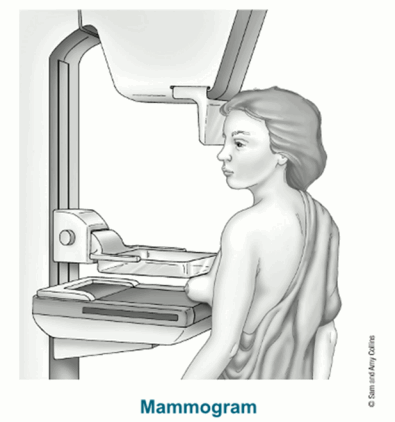Understanding Mammography/Mammogram
The National Cancer Institute defines a mammogram as an x-ray picture of the breast after mammography. Mammographies are useful screening and diagnostic tools. They help to check for breast cancer in case of no signs/symptoms: screening. They are also used to confirm the presence of breast cancer in the case of a prevailing lump or other sign/symptom of the disease (National Cancer Institute, 2014).
Conducting Mammography
When conducting a mammography, the breast is sandwiched between two plates, which compress the breast and are connected to a mammogram machine. The mammogram machine consists an adjustable at the top, and a fixed one at the bottom. An x-ray film is attached to the fixed bottom plate to enable it record the mammogram image. In order to avoid prolonged exposure to x-ray, while simultaneously obtaining a clearer picture, the breast is compressed to a thinner layer of tissue as indicated in the figure below.

A computer-generated black and white image is produced during this procedure. A radiologist is the only capable person who can interpret this image. These computer-generated mammograms, otherwise known as digital mammograms are preferred in detecting cancer in women below the age of 50, and among women who have dense breast tissue (American Cancer Society, 2014). The mammograms are used to provide information necessary in the early detection of breast cancer.
Reliability and validity of Mammography
In this context, validity is the ability of the mammography to distinguish clearly between those who have breast cancer, and those who don’t. The issue of validity and reliability of mammograms is an area that has not been widely researched. However, there are numerous indications of the unreliability and poor validity of results as indicated by the occurrence of false positive and false negative results (Andolina and Lille, 2010). Available studies have mainly focused on the validity of health belief model variables in relation to mammography screening interventions. The reliability of mammography is not 100% due to the presence of false-negatives and false-positives, which apparently are inevitable.
Sensitivity and Specificity of Mammography
Mammography has a high sensitivity because it is able to detect prevailing cancers. Andolina and Lille (2010) report that the mammogram is not without some false negatives of between 5 and 15%. These false alarms could be attributed to cancers not diagnosable through a mammogram, young age, dense breast tissue, mucinous or lobular breast tissue, or rapidly enlarging cancer (National Cancer Institute, 2014). According to Andolina and Lille (2010), specificity of mammography is higher when used to screen the larger population in comparison to diagnosis of the cancer. Despite the fact that the mammography can indicate the presence of a malignancy or benign disease, it does not distinguish between these two. The predictive value of mammography is highly dependent on the sensitivity and specificity of the test.
Controversies
Despite the fact that the mammogram saves lives through early diagnosis of cancer; hence, prompting immediate treatment, there is contention over the high rates of overdiagnosis and distress resulting from false alarms. Apparently, mammography results in negative psychological wellbeing due to issues with specificity and sensitivity (Bond et al., 2013).
Ethical Issues
The diagnosis of cancers that may not be harmful exposes a woman to risks associated with therapy, lymphedema and post-radiation effects such as occurrence of new cancers and scarring (National Cancer Institute, 2014). The false-negatives develop a false complacency and may ignore subsequent warning symptoms; hence, delaying diagnosis as the progression of the disease continues. The false-positives are subjected to unnecessary therapy that is costly, uncomfortable and harmful due to associated psychological distress.
References
American Cancer Society. (2014). How is a mammogram done? Web.
Andolina, V., & Lille, S. (2010). Mammographic Imaging: A Practical Guide (3rd ed.).New York: Lippincott Williams & Wilkins.
Bond, M., Pavey, T., Welch, K., Cooper, C., Garside, R., Dean, S., & Hyde, C. (2013). Psychological consequences of false-positive screening mammograms in the UK. Evidence Based Medicine, 18, 54-61.
National Cancer Institute. (2014). Breast Cancer Screening (PDQ®). Web.